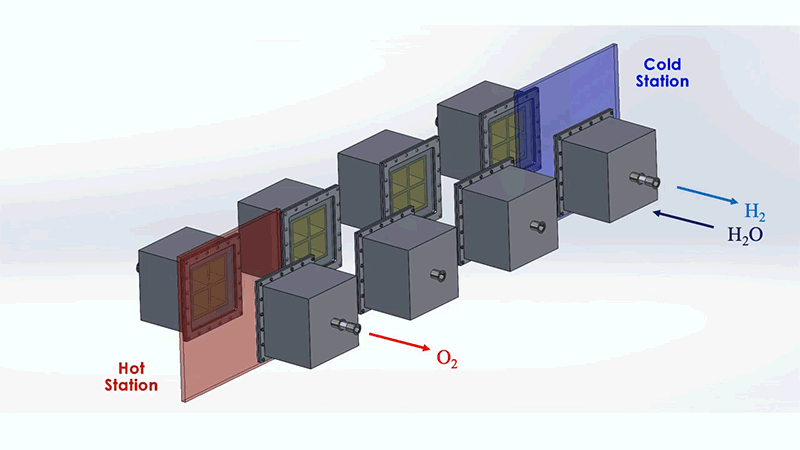Fuel from sunlight
An MIT system could harness 40% of solar heat to produce clean hydrogen for transportation.
Hydrogen is a clean fuel that can power trucks, ships, and planes, but producing it usually requires fossil fuels. A new system conceptualized by MIT engineers uses the sun’s heat to split water and generate hydrogen without emitting greenhouse gases.
Previous attempts to produce solar thermochemical hydrogen, or STCH, have used only about 7% of incoming sunlight. The MIT researchers, led by professors Ahmed Ghoniem and Harry Tuller and postdoc Aniket Patankar, estimate that their design could harness up to 40%, making STCH a potentially scalable, affordable option to help decarbonize transportation.

In an STCH system, water in the form of steam is exposed to an oxygen-deficient metal oxide, which then grabs its oxygen, leaving hydrogen behind (a process similar to rusting but faster). The oxidized material is typically reheated in a vacuum to remove oxygen so the process can be repeated once the material cools.
In the MIT system, a train of box-shaped reactors housing the metal oxide would run on a circular track around a solar thermal source, such as a concentrated solar plant’s central receiving tower. Each reactor would first pass through a hot station, exposing it to the sun’s heat at temperatures of up to 1,500 °C, pulling oxygen out of the metal oxide and readying it to grab oxygen from steam. Upon moving to a cooler station (around 1,000 °C), the reactor would be exposed to steam to produce hydrogen.
Reactors on opposite sides of the track would exchange heat through thermal radiation, cooling hot reactors and heating cool ones—and keeping heat within the system. A second set of reactors operating at lower temperatures and circling the first train in the opposite direction would carry another oxidizing metal, which would absorb oxygen from the inner reactors. Both trains would run continuously, generating separate streams of hydrogen and oxygen.
The team plans to build a prototype and test it at Department of Energy labs.
Keep Reading
Most Popular
10 Breakthrough Technologies 2024
Every year, we look for promising technologies poised to have a real impact on the world. Here are the advances that we think matter most right now.
Google DeepMind used a large language model to solve an unsolved math problem
They had to throw away most of what it produced but there was gold among the garbage.
The worst technology failures of 2023
The Titan submersible, lab-grown chicken, and GM’s wayward Cruise robotaxis made our annual list of the worst in tech.
AI for everything: 10 Breakthrough Technologies 2024
Generative AI tools like ChatGPT reached mass adoption in record time, and reset the course of an entire industry.
Stay connected
Get the latest updates from
MIT Technology Review
Discover special offers, top stories, upcoming events, and more.